by
Rhythm Scene Staff
| Jun 01, 2014
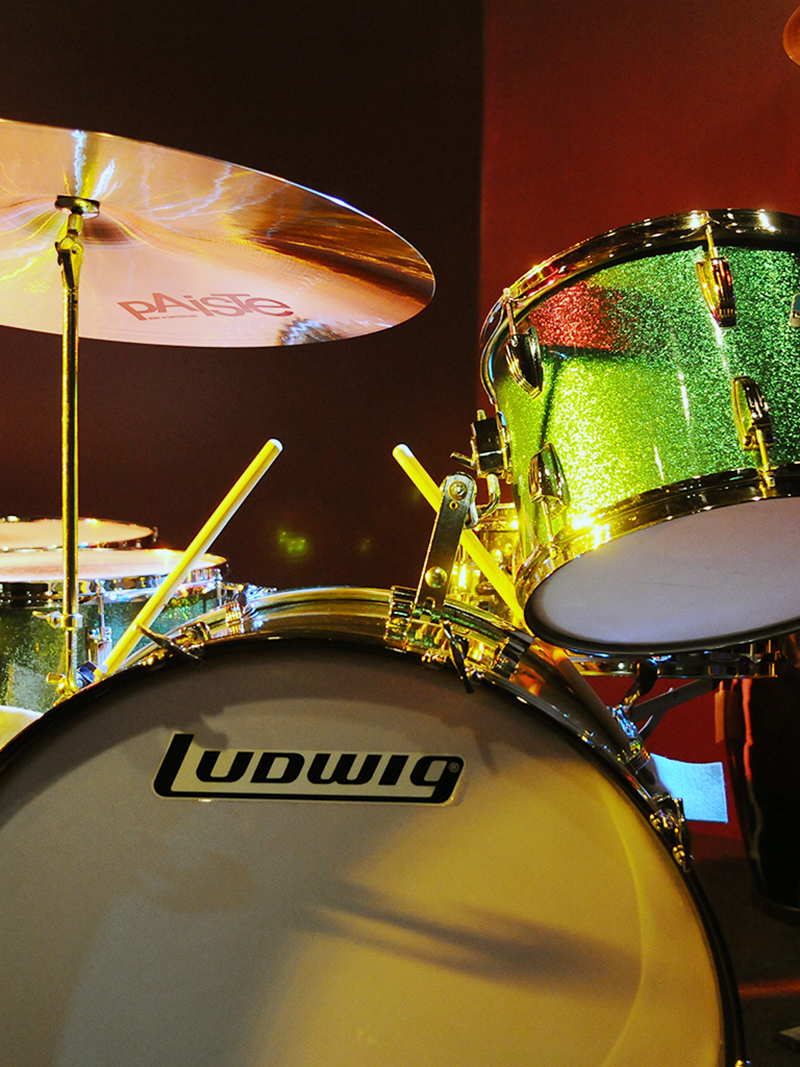
In November 2013, Rhythm! Discovery Center opened its newest exhibit, DRUMset: Driving the Beat of American Music. This exhibit explores the evolution of the drumset from its beginnings at the end of the 19th century as a group of sound effects to its present-day status as the backbone of contemporary music. Along the way, visitors will see the innovations in percussion that shaped each musical era, from early swing and bebop to the British Invasion and modern indie rock.
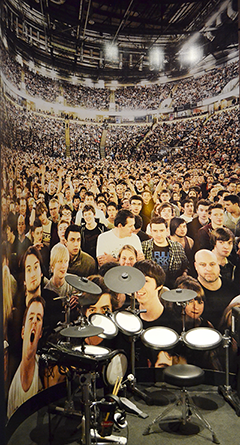 Like every exhibit at R!DC, visitors will also have a chance to make their own music by playing one of the several interactive components located in the galleries. Rock out on one of the electronic drumsets and play along with “Low Rider,” “When the Levee Breaks,” or “Billie Jean.” Or try the many styles of bass drum pedals to discover the differences in straps, beaters, and footboards.
Like every exhibit at R!DC, visitors will also have a chance to make their own music by playing one of the several interactive components located in the galleries. Rock out on one of the electronic drumsets and play along with “Low Rider,” “When the Levee Breaks,” or “Billie Jean.” Or try the many styles of bass drum pedals to discover the differences in straps, beaters, and footboards.
Three “mini-exhibits” are also located in DRUMset. The first features display cases containing drums and accessories from several famous drummers including Joe Morello, Neil Peart, and Ed Shaughnessy. The second showcases the evolution of snare drums and bass drum pedals from the turn of the 20th century to the present day. Finally, the last mini-exhibit gives a brief history of electronic drums and percussion through a display of several early electronic percussion instruments and an interactive timeline.
DRUMset begins with the story of how and why the first drumsets came to be. The drumset is a collection of instruments, and how they were combined is the first step in this century-long evolutionary process. The drumset can trace its beginnings to post-Civil War America. Beginning in the late 19th century, music styles developed requiring drummers to play more than one part at a time. This gave way to the first drumsets, which consisted of a snare drum propped on a chair and a bass drum, usually left over from use in a military setting. These early drumsets were played by using both hands, one for each drum, leading to the term “double drumming.”
Double Drumming Drumset
This double drumming set consists of a 1929 Leedy Reliance Model bass drum and a 1909 Walberg & Auge snare drum. Although this specific kit was never played as a double drumming drumset, it is representative of early drumsets that were cobbled together with whatever drums and traps were available. Notice the large bass drum. The bass drums of early drumsets were larger than those of today, as they were previously used as marching drums. Players used suitcases and chairs to prop up the instruments, forming the first true drumsets.
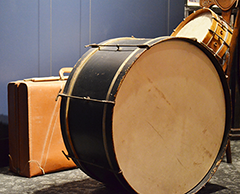
Double Drumming Drumset
Bass drum on loan from Nancy Kraft, c. 1929 | Snare drum donated by Karen Vibe, c. 1909
Walberg & Auge Folding Bass Drum with Overhang Pedal
The Walberg & Auge folding bass drum was used by gigging drummers to haul their entire setup in one convenient package. The drum folds from the center and could hold cymbals, a snare drum, and traps. It is outfitted with an early bass drum pedal, known as an overhang pedal, which attaches to the top of the drum with a long metal rod and uses a leather strap to provide tension to the foot pedal. The overhang pedal represents an early evolutionary step from drummers only using their hands to incorporating all limbs.
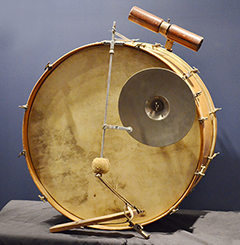
Walberg & Auge Folding Bass Drum with Overhang Pedal
Bass drum donated by Karen Vibe
Pedal and traps on loan from Scott Friedman, c. 1910
Bass drum: 14x26. Additional hardware: Overhang pedal, two-tone woodblock
Ludwig & Ludwig Bass Drum with Traps and Interior Lighting
This bass drum dates to the 1920s and was used by famed bandleader Fletcher Henderson. It has a painted front head, which was a popular artistic choice among drummers of the time. This drum also features an interior light that changes colors to mimic a sunset and sunrise. The light helped to regulate the humidity in the drum, providing a more consistent sound from the calfskin heads. The drum is outfitted with traps, such as a Chinese tom-tom, cowbell, and woodblock.
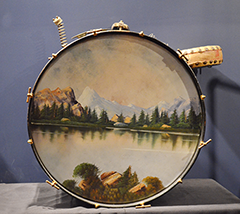
Ludwig & Ludwig Bass Drum with Traps and Interior Lighting
Donated by Charlie Benton, Early 1920s. 2006-01-03
Bass drum: 14x28, painted calfskin drum head, interior lighting
Roy Knapp Early “Trap” Drumset
This drumset was used by famed percussionist Roy Knapp, who was a studio musician for WLS-AM in Chicago during the early days of broadcast radio, which included playing on the famed show National Barn Dance. He employed many traps on his kit that allowed him to create sound effects for use during radio broadcasts. Knapp’s drumset also has a bell set and large chimes, which further increased his sound options. Knapp was also a respected drum teacher, and was known for his Roy C. Knapp School of Percussion, which he began in 1938. Some of his students included Gene Krupa, Louie Bellson, Dave Tough, Baby Dodds, and Bobby Christian.
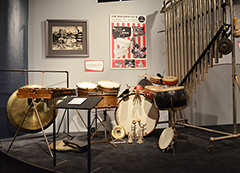
Roy Knapp Early “Trap” Drumset
Donated by James L. Knapp, c. 1920s-1930s. 1981-01
Bass drum: 12x24; wooden shell, single tensioned. Snare drum: WFL Drum Co.; 6x14, wooden shell. Chinese tom-toms: 3x6, 3.75x9, 6x11, 9x12; painted Asian motif. Cymbals: 8-inch splash, 12.5-inch choke. Additional instruments: Copper-shell timbales, snowshoe pedal, woodblock, cowbell, temple block, triangle
WFL Drum Co. Bottom-Tacked Tom Drumset
The WFL Drum Company produced drums from the 1930s through the 1950s, during a time of experimentation with drumset design. This kit showcases a progression in the design of the tom-tom. The tom-toms on this kit have tacked heads on the bottom of each drum. These tacked heads are secured to the shell of the drum by metal rivets that are driven directly into the wood. This meant that the drummer had fewer sound options when playing the tom-toms. The drums on this kit also feature a custom overlay that was produced specifically for the customer who purchased them.
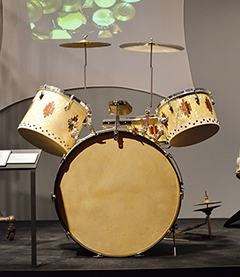
WFL Drum Co. Bottom-Tacked Tom Drumset
On loan from Harry J. Cangany Jr., Late 1930s
Bass drum: 14x28; Leedy mounting rack. Snare drum: Ray Bauduc Dixieland Swing Model; 7x14; twin-strainer. Rack tom-toms: 9x13, 12x14. Additional instruments: Mounted WFL woodblock
Slingerland Radio King Drumset with “Rolling Console”
This most noticeable feature of this drumset is the unique rolling console system that contains mounts for the tom-toms, snare drum, cymbals, and a Plexiglas stand for holding traps. However, this drumset is also special as an example of the evolution of tom-tom design.
During the 1930s, H.H. “Bud” Slingerland, founder of the Slingerland Drum Co., was working closely with drummer Gene Krupa to develop a new style of tom-tom that was easily mounted to a drumset, while also providing more sound options. This led to the creation of the bottom lug-secured tom-tom. Drummers now had multiple sound options for tom-toms, and could easily tune their drums to their liking. Although many people know Krupa for his playing ability, he was also extremely influential in the evolution of the drumset.
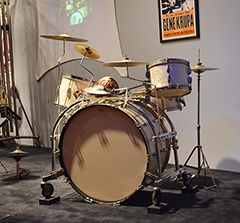
Slingerland Radio King Drumset with “Rolling Console”
On loan from Daniel Glass, Mid 1930s
Bass drum: 14x26, separate tension. Snare drum: Gene Krupa Model “Cloud Badge” Radio King, 6.5x14, hoops with embossed logo. Rack tom-tom: 9x13. Floor tom-tom: 16x16. Cymbals: Zildjian; 8-inch splash, 12-inch hi-hats, 14-inch crash, 15-inch crash. Rolling console: Late 1930s design, incorporating a Plexiglas trap table, locking wheels, a remote arm for holding the snare basket, hoop clips, stabilizer bar
Gretsch Progressive Jazz Champagne Sparkle Drumset
Gretsch Round Badge drumsets were produced from the early 1930s to 1970, and became the most sought-after setup for playing jazz and bebop during the 1940s and 1950s. They get their name from the shape of the Gretsch logo that is affixed to each component. This drumset was produced in the early 1960s, and is one of the first 6-ply models.
This Round Badge drumset has two snare drums, one of which is a Progressive model jazz snare. It is smaller, at 4x14, and has a punchier sound that allows it to stand out among the many sounds of jazz and bebop. The kit also features a champagne sparkle wrap on its shells that gives it a hip look to go along with the music it played.
This kit represents an evolutionary step toward smaller drum sizes. Keep that in mind as we look at the next drumset.
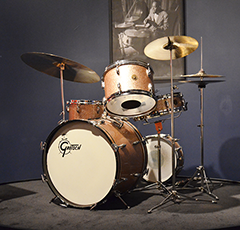
Gretsch Progressive Jazz Champagne Sparkle Drumset
On loan from the collection of Alan K. Green, Dallas, TX
1960s. Bass drum: 14x20. Snare drum: 5.5x14, Progressive model 4x14. Mounted tom-tom: 8x12. Floor tom-tom: 14x14
WFL Drum Co. White Marine Pearl Cocktail Kit
As bebop and jazz became more popular, small venues popped up around the country providing an outlet for these new styles of music. Since these small venues had tiny stages, enterprising percussionists were required to find a new way to get the same sound from smaller setups. Cocktail kits were the answer, as they packed in the main components of a full range drumset into a compact kit. This not only allowed for drummers to play in smaller spaces, but also made traveling with these kits much easier. Gigging musicians in major cities were required to walk or take public transit, which is a tough task while carrying a full drumset. The cocktail kit made the load much lighter.
The drummer used the cocktail drum for a tom-tom sound on the top head and had a beater on the bottom head for the bass tone. The snare and cymbals round out this jazzy set.
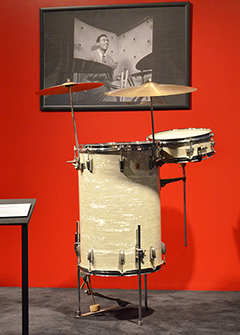
WFL Drum Co. White Marine Pearl Cocktail Kit
On loan from Denny Hankla, 1960
Cocktail drum: 16x23, with pedal assembly. Snare drum: 4x13. Cymbals: Zildjian 13-inch, Zildjian 17-inch. Additional hardware: Snare drum stand mounted to shell of cocktail drum
Rogers Holiday Sparkle Drumset with “Swiv-O-Matic”
This Rogers kit represents the combination of historic setups with modern designs. Although it resembles most modern four-piece setups, it was the first drumset to use the revolutionary “Swiv-O-Matic” hardware, which consists of ball joints that give large ranges of motion to each component. Drummers used this new invention to customize their setups to match their playing style.
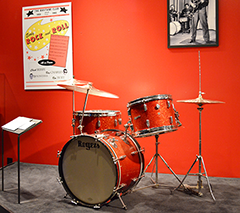
Rogers Holiday Sparkle Drumset with “Swiv-O-Matic” Hardware
On loan from Daniel Glass, 1960
Bass drum: 14x20. Snare drum: 5x14. Rack tom-tom: 9x13. Floor tom-tom: 16x16
Ludwig Super Classic Outfit Black Oyster Pearl Drumset
In 1964, the Beatles made their first appearance on American television, playing three nights on The Ed Sullivan Show. Beatles drummer Ringo Starr sat behind a Ludwig black oyster pearl drumset, which spurred countelss drummers to replicate his kit.
This drumset is a representation of the black oyster pearl wrap that was so famously used by Ringo. It does not match the exact specifications of the kit Ringo played in 1964, but shows the important role he played in making Ludwig and the black oyster pearl wrap the most sought after drums in the U.S.
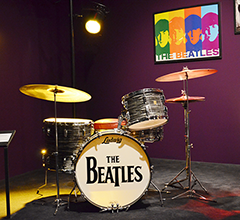
Ludwig Super Classic Outfit Black Oyster Pearl Drumset
On loan from the collection of Andy Mayer, Dallas, TX, 1960s
Bass drum: 14x22. Snare drum: 5x14 Jazzfest. Ride tom-tom: 9x13. Floor tom-tom: 16x16. Additional hardware: Red topped oyster drum throne, Ludwig Speed King bass drum pedal, bass drum anchor
John Bonham Ludwig Green Sparkle Super Classic Outfit
This drumset was used by Led Zeppelin’s drummer, John Bonham, during live performances from 1971–73. It was also used on every Led Zeppelin studio album beginning with Led Zeppelin IV and excluding Presence. Bonham claimed this kit had the best sound of any drumset he used. It features a green sparkle wrap and Bonham’s famous gong. Notice how the wrap on the larger of the two floor toms is slightly brighter? It had to be replaced, as Bonham frequently put out cigarettes on the drum while playing.
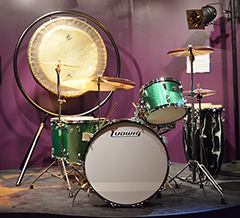
John Bonham Ludwig Green Sparkle Super Classic Outfit 980P Drumset
On loan from Jeff Ocheltree, 1971
Bass drum: 14x26. Snare drum: 6.5x14. Rack tom-tom: 10x14. Floor tom-toms: 16x16, 18x18. Cymbals: Paiste; 24-inch ride, 18-inch medium, 16-inch medium, 15-inch Giant Beat hi-hats
Neil Peart’s Slingerland 10-Piece Drumset
This is the original drumset that Neil Peart used when he went on his first tour with Rush. It was used on many subsequent tours, and was the drumset featured on the albums Fly By Night (1975), Caress of Steel (1975), 2112 (1976), and the live album All the World’s a Stage (1976), where it was featured on the album cover.
Peart was able to get his large sound by using two bass drums. Although the style existed before the 1970s, the use of double bass drums proliferated during this era, going on to become synonymous with the hard rock sound. Notice anything about the bass drum heads? The head to the right is torn from when Peart was cutting a hole for his microphone and nicked the plastic. He was forced to play a show that night with the head, which caused it to tear even more.
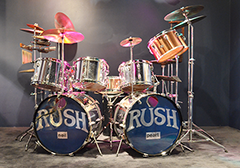
Neil Peart’s Slingerland 10-Piece Drumset
On loan from Dean Bobisud, 1974
Bass drum (2): 14x22, chrome wrap. Snare drum: Slingerland, 5.5x14, copper wrap. Rack tom-toms (2): 9x13, 10x14, chrome wrap. Floor tom-tom: 16x16, chrome wrap. Concert toms: 5.5x6, 5.5x8, 6.5x10, 8x12, copper wrap. Cymbals: (2) Zildjian 8-inch splash, 13-inch New Beat hi-hats, 16-inch crash, 18-inch crash, 18-inch Pang, 20-inch crash, 22-inch” Ping ride. Additional hardware: Deagan 1560 Glockenspiel, LP bell tree, LP wind chimes, temple blocks, cowbell
Ndugu Chancler’s Yamaha “Jacaranda” Recording Custom Drumset
Ndugu Chancler played this drumset on Michael Jackson’s song “Billie Jean” from the iconic album Thriller (1982). Chancler, a prolific session drummer and educator, was asked to play on Thriller’s only track featuring acoustic drums. The heads on this drum are the same heads used to play “Billie Jean,” including the prototype Kevlar snare head that is a hybrid version of a marching snare head.
Chancler worked closely with the Yamaha design team to produce the hardware on this drumset. His guidance led to this drumset having much stronger and sturdier hardware than what was previously used.
VIDEO: Ndugu Chancler at Rhythm! Discovery Center
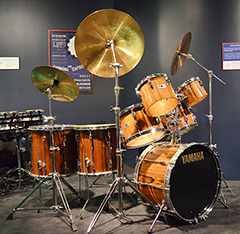
Ndugu Chancler’s Yamaha “Jacaranda” Recording Custom Drumset
On loan from Ndugu Chancler, 1980s
Bass drum: 14x22. Snare drum: 6.5x14. Rack tom-toms: 6x8, 8x10, 8x12, 9x13. Floor tom-toms: 14x14, 16x16
Glenn Kotche’s Sonor Designer/Delight Series 2003 Drumset
Artists such as Glenn Kotche, who is most famous for his work with the band Wilco, are pushing the envelope in terms of what drummers and percussionists are able to do. Harkening back to the days of trap drummers (remember Roy Knapp’s kit?), Kotche’s drumset employs numerous gadgets to make his sound even more unique. Bells, crotales, a kalimba, and even a fruit basket are used on this kit to produce the unique tones now associated with Kotche. The snare drum head on this kit has springs, wood, and other small items that Kotche attached to create a custom sound not found on any other drums. He will even use a violin bow on these components.
Kotche’s kit is not only an acoustic instrument. He outfitted each drum with a contact mic and drum machine trigger that allows him to manipulate the sounds through a sound mixer. He will also use the mixer to create backing tracks that he plays along with in his solo performances. This kit shows how the drumset has evolved with the style of electronic music that has become more popular in the last several years.
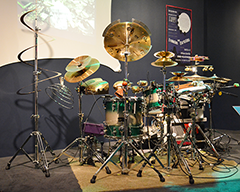
Glenn Kotche’s Sonor Designer/Delight Series 2003 Drumset
On loan from Glenn Kotche, 2000s
Floor tom-tom: 14x14 with beater. Rack tom-tom: 8x10.
Snare drum: 6x14, with custom head. Additional drums: 10-inch Sonor jungle snare drum, LP 11-inch compact conga. Cymbals: Zildjian 16-inch A EFX cymbal with jingles, Zildjian 18-inch ZHT EFX, Zildjian 12-inch A hi-hats, Zildjian 6-inch zil bell, Zildjian 9.5-inch zil bell, Zildjian 8-inch Trashformer, Zildjian 10-inch Trashformer, Zildjian 14-inch Trashformer, Zildjian 18-inch Spiral Trash, Zildjian 8-inch prototype bell cymbal, LP 7-inch ice bell, LP 9-inch ice bell, Zildjian high octave crotales, Zildjian low octave crotales. Additional instruments: LP deluxe vibraslap, LP chamber vibraslap, LP One Shot shakers, LP Hugh Tracey Kalimba, 18” Factory Metal Percussion Cross Benderz, Chinese cricket boxes, spiral fruit basket, Korean Shaman bells, almglocken, Musser M656 Orchestra Concert Band Bells. Additional accessories: Mackie mixer, Line 6 DL4 Delay module, Roland TR-10 drum triggers
Transformation & Variation
The drumset evolved to solve problems as music changed and drummers pushed boundaries. At times, the drumset grew. At other times, it became more streamlined. Recently, it has gone electronic. What will drumsets of the future look like? We can only guess, but we know drummers have both embraced innovation and been influenced by the past.
For more information on Rhythm! Discovery Center and DRUMset: Driving the Beat of American Music visit www.rhythmdiscoverycenter.org. Rhythm! Discovery Center is located in the heart of downtown Indianapolis, Indiana and is open Monday–Saturday, 10 a.m. – 5 p.m. and Sunday, noon – 5 p.m. DRUMset will be on display through January 2016.